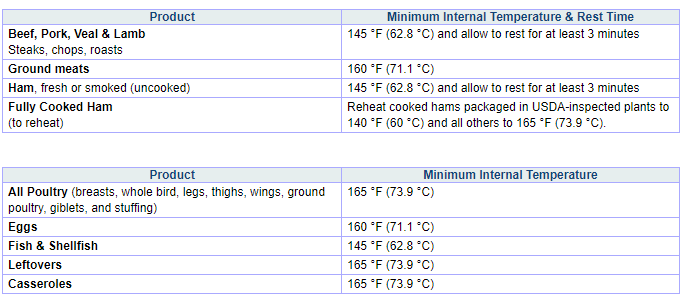The other day my wife and I wanted to make some candy, but the recipe called for a candy thermometer. All we had on hand was a digital meat thermometer, so I wanted to see if that would work or if there was a difference in the two thermometers. After all, both are used in the kitchen for cooking.
After some research, I realized that there is a difference between candy thermometers and meat thermometers. Meat thermometers usually have a smaller temperature range, up to 200 °F, and is a pointed device to insert into meat. A candy thermometer on the other hand measures much higher temperatures, usually up to 400 °F, and is long enough to sit in a pot of boiling liquid.
The length of a meat thermometer makes it tough to do the job of a candy thermometer. A candy thermometer is long and narrow which makes it great for checking the temperature of hot sugar or oil but it would have difficulty piercing a meat to get a temperature reading.
Why Food Thermometers
A large part of cooking comes down to science. That science decides when certain foods are finished cooking based on temperature.
When meats are concerned, knowing the temperature of your food can make or break the finished product. If the temperature is too low, the meat could make your guests ill. If the meat temperature is too high, your meal could be chewy and not edible.
As far as candies are concerned, you will not be able to finish a candy project without the correct temperature. All candy is usually started with sugar. Sugar is boiled to a specified temperature. If directions or temperature is not followed, you will be stuck with a pot of ingredients instead of some yummy candy.
Meat Thermometers
A meat thermometer usually has a metal pointed stick attached to a dial (either digital or analog) that shows you the temperature. Usually, this is really useful for cooking large cuts of meat such as chicken breasts, whole fish, beef or pork tenderloin, or a whole turkey.
Many times when cooking these large meats, it is difficult to determine the temperature based just on cooking time or visually. Think of that big thanksgiving bird that your mom used to cook.
Whether it was a 10 pound turkey or a 20 pound turkey, most people just read similar instructions and guess on when it is complete. Using a thermometer allows you to take the guesswork out, especially when it is one of the most important meals of the year!
There are also many meats that require a safe minimum internal temperature. For reference, the USDA provides a useful guide.

If you are trying to cook that perfect beef product at home, a meat thermometer can help put your dish on the table at the perfectly juicy. Whether tenderloin or filet mignon, a meat thermometer can make you look like a professional chef!
Candy Thermometer
Whether you are looking to make candy like brittle, fudge or any other candies that you enjoy, a candy thermometer is a must! A meat thermometer can help you create the perfect dish, but a candy thermometer is necessary to even complete the dish!
Usually a candy thermometer goes up to temperatures around 400 °F. Candy (and sugar) has a boiling temperature much higher than water, so you need a device that can measure these high temperatures.
The shape of a candy thermometer is usually really long. This allows the thermometer to sit deep in a pot of boiling sugar or oil with the reading comfortably away from the heat.
Other Uses for a Candy Thermometer
Besides making candy, a candy thermometer can work really well for making sauces (such as caramel), other candy syrups or for frying things. Whether you are frying a decadent treat or heating up for some fried chicken, a candy thermometer can do the trick.
For frying foods, the right temperature is generally 350 °F or higher. If the temperature gets too hot, your food will run the risk of getting burned. Low oil temperatures can lead to greasy foods. I know greasy may be something you think about with fried foods, but it should be crispy without too much grease soaking in.

